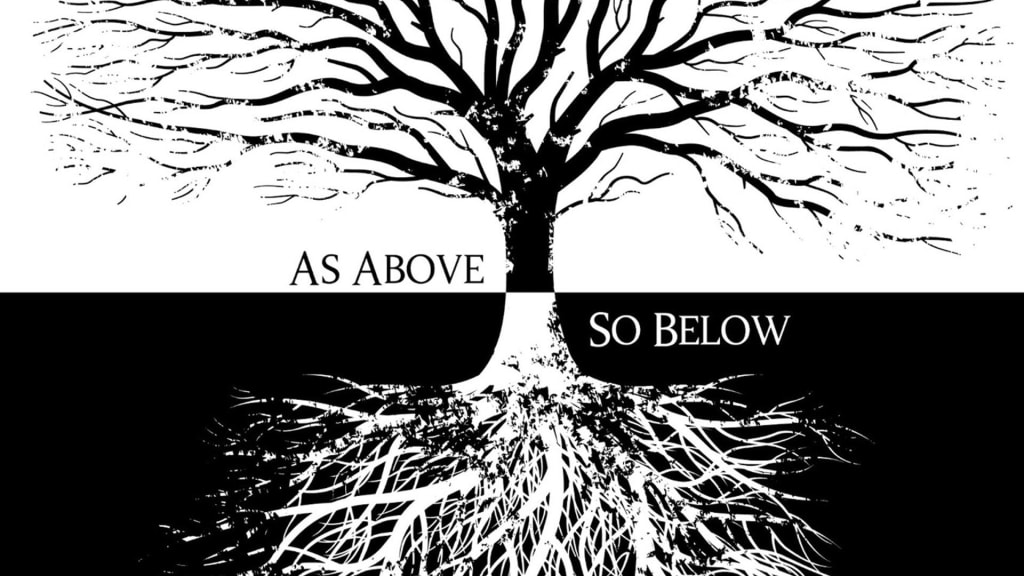Understanding the Art of Hermetic Alchemy and the 7 Principles Part 1
Seven Universal Laws


The Hermetic Philosophy, often associated with the teachings of Hermes Trismegistus, is a philosophical and spiritual tradition that has had a significant influence on Western esotericism and occultism. It is based on a set of principles and teachings that are often referred to as the "Seven Hermetic Principles" or the "Seven Universal Laws." These principles are said to govern the universe and are considered to be the foundational concepts of Hermeticism. Here is an overview of the Seven Hermetic Principles:

1. The Principle of Mentalism: This principle states that "All is Mind; the Universe is Mental." It suggests that everything in the universe is a product of the mind, and that the fundamental reality is mental in nature.
Key aspects and implications of the Law of Mentalism include:
Primacy of Mind: This law asserts that the mind is the creative force behind all that exists. Everything in the universe, including matter, energy, and consciousness, is ultimately derived from and shaped by the universal mind or divine intelligence.
Thoughts Create Reality: According to this law, thoughts are not merely passive reflections of reality but active forces that shape and influence one's experiences. What individuals think and believe can manifest in their lives and the world around them.
Unity of All: The Law of Mentalism implies that there is a fundamental interconnectedness and unity to all things because they are products of the same universal mind. It suggests that separateness is an illusion, and everything is part of a larger, unified whole.
Creative Power: Understanding the creative power of the mind is a central theme in the Law of Mentalism. It encourages individuals to recognize their role as co-creators of their reality and to use their thoughts and intentions consciously to shape their lives.
Transcending Materialism: This law challenges the purely materialistic view of the universe and encourages a deeper exploration of the spiritual

2. The Principle of Correspondence: As above, so below; as below, so above. This principle emphasizes the idea that there is a correspondence between the macrocosm (the universe) and the microcosm (the individual), and that patterns and principles in one level of reality are reflected in others.
Universal Connection: This principle suggests that there is a correspondence or connection between different levels or planes of existence. It implies that patterns, laws, and phenomena observed in one level or aspect of reality are mirrored or reflected in other levels or aspects.
Macrocosm and Microcosm: The principle emphasizes the idea that there is a relationship between the macrocosm (the larger universe or cosmos) and the microcosm (the individual or smaller aspects of existence). What occurs in the universe as a whole can have parallels or analogies within the individual.
Unity of All: The Principle of Correspondence points to the interconnectedness and unity of all things. It suggests that everything is interrelated, and by understanding one level of reality, you can gain insights into other levels.
Hermetic Thought: In Hermeticism, this principle is closely tied to the idea that knowledge of the universe can be gained by studying oneself and vice versa. By understanding the laws that govern the cosmos, one can apply those same principles to their own life and spiritual development.
Applications: The Principle of Correspondence can be applied in various ways. For instance, in the realm of esoteric and spiritual practices, it might be used to understand how the energies of the cosmos correspond to the energies within the human body. It can also be applied in the study of symbolism and metaphysics.
Holistic Perspective: This principle encourages a holistic perspective on reality, where the physical, mental, and spiritual dimensions of existence are seen as interconnected and influenced by each other.

3. The Principle of Vibration: This principle asserts that everything is in a state of vibration, and that differences in vibration create the diversity of forms and manifestations in the universe.
Dynamic Nature of the Universe: The Principle of Vibration underscores the dynamic and ever-changing nature of the universe. It suggests that there is constant motion and activity in all aspects of existence, from the smallest particles to the largest celestial bodies.
Vibration as Energy: In this context, vibration is not limited to physical oscillations but extends to the idea that everything is a form of energy. It implies that matter, energy, and consciousness are interconnected and can be understood in terms of varying vibrational frequencies.
Law of Resonance: This principle implies that objects or entities with similar vibrational frequencies are in resonance with each other. When two things vibrate in harmony, they can influence each other more strongly.
Manifestation of Form: Vibration is considered the creative force behind the formation of physical and non-physical phenomena. Higher-frequency vibrations may result in subtler, less dense forms, while lower-frequency vibrations give rise to denser, more material forms.
Spiritual and Metaphysical Implications: The Principle of Vibration is often applied to spiritual and metaphysical practices. It is seen as a key to understanding the energy body, chakras, auras, and other subtle aspects of consciousness and spirituality.
Harmony and Balance: In Hermeticism, maintaining harmony and balance in one's life is essential. This principle reminds individuals of the importance of aligning themselves with harmonious and positive vibrations to achieve balance and well-being.
Applications: This principle has applications in various fields, including physics, metaphysics, and holistic health. It is often used as a framework for understanding the interconnectedness of all things and the role of energy in healing and personal growth.
4. The Principle of Polarity: This principle states that everything has its opposite or polar counterpart. It suggests that opposites are two extremes of the same thing and that they are interconnected.

Existence of Opposites: This principle asserts that opposites or polarities are inherent in all aspects of existence. For every quality, there is an opposite or contrasting quality. For example, hot and cold, light and darkness, love and hate, and positive and negative are pairs of opposites.
Unity in Duality: While opposites appear to be in conflict, the Principle of Polarity suggests that they are actually two extremes of the same thing. It implies that there is a continuum or scale between these opposites, and they are interconnected.
Relativity: This principle also highlights the idea of relativity. Whether something is perceived as "good" or "bad" depends on one's perspective and the context in which it is viewed. What may be considered hot in one context might be seen as cold in another.
Balance and Harmony: In Hermeticism and other spiritual and philosophical traditions, achieving balance and harmony between polarities is seen as a key to personal growth and spiritual development. It suggests that individuals can find balance by navigating between extremes and finding a middle path.
Transmutation: The Principle of Polarity implies that it is possible to transform or transmute one extreme into another. For example, the transmutation of negative thoughts into positive ones or the transformation of ignorance into wisdom is seen as a way to evolve and grow.
Integration: Some interpretations of this principle suggest that true wisdom and understanding come from recognizing and integrating both sides of a polarity. By understanding and integrating opposites, individuals can achieve a more holistic perspective.
Applications: This principle is often applied in various areas, including psychology, spirituality, ethics, and personal development. It encourages individuals to examine their beliefs, attitudes, and behaviors in light of polarities and seek balance and integration.
Overall, the Principle of Polarity serves as a reminder that the world is characterized by dualities and contrasts, and it encourages individuals to embrace the interplay between opposites as a means of personal growth and understanding the complexities of existence. It also underscores the idea that opposites are not separate but interconnected aspects of the same underlying reality.
About the Creator
Be Inspired - Be Motivated
Would you like to clear out what's blocking your energy so you can manifest the life YOU want?






Comments
There are no comments for this story
Be the first to respond and start the conversation.